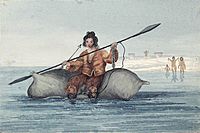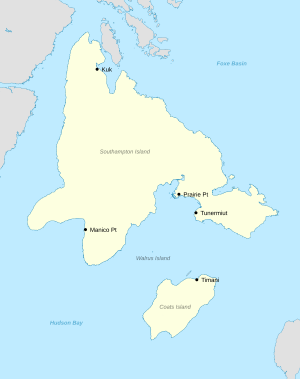Sadlermiut facts for kids
 A Sadlermiut man paddling on an inflated walrus skin, 1830 |
|
| Regions with significant populations | |
|---|---|
| Canada | |
| Languages | |
| Undetermined | |
| Religion | |
| Possibly shamanism | |
| Related ethnic groups | |
| Dorset culture, other Inuit, Aleuts, Yupiks |
The Sadlermiut were a group of Inuit people who lived mostly on and around Coats Island, Walrus Island, and Southampton Island in Hudson Bay. They lived quite isolated from other groups. Their name, Sadlermiut, comes from Sadlerk, which is now called Salliq (the Inuktitut name for Coral Harbour, Nunavut).
They survived until the early 1900s. For a long time, people thought they might be the last people from the ancient Dorset culture. This was because the Sadlermiut had a unique culture and way of speaking that was different from other Inuit. Their culture seemed to mix parts of both the Dorset and Thule societies. However, recent studies of their genes show they were only related to the Inuit (Thule people). This means their unique culture probably came from being isolated, not from mixing with Dorset people. Scientists are still trying to figure out how they got Dorset tools and ideas without having Dorset genes.
Contents
A Look Back: Sadlermiut History
First Meetings with Outsiders
In 1824, a ship called HMS Griper, led by Captain George Francis Lyon, stopped near Cape Pembroke on Coats Island. The sailors met a group of Inuit who spoke a "strange dialect." These were the Sadlermiut.
Over time, the Sadlermiut started to have more contact with people from Western countries. Sadly, like many Native groups in North America, the Sadlermiut were not used to Western diseases. They often got sick from illnesses that were new to them.
The Sadlermiut Disappear
By 1896, only about 70 Sadlermiut people were left. Then, in the fall of 1902, a British trading ship called the Active visited Cape Low on Southampton Island. It is believed that some Sadlermiut caught a sickness, possibly a type of flu or fever, from a sick sailor on the Active. This illness then spread quickly through their community.
By the winter of 1902-1903, almost all the Sadlermiut people had died. Only one woman and four children survived. This sad event led to the end of the Sadlermiut as a distinct group.
Studying Sadlermiut Culture
In the 1950s, a scientist named Henry B. Collins from the Smithsonian Institution studied old Inuit house ruins in the Canadian Arctic. He found that the ruins at Native Point showed the unique Sadlermiut culture, which used to be very widespread. He also found clues that suggested the Sadlermiut might have been the last people connected to the ancient Dorset culture.
Where Did the Sadlermiut Come From?
The Sadlermiut are famous for having a culture and language that was different from other Inuit groups. This was likely because they lived in a very isolated area. Scientists have come up with different ideas to explain their unique culture.
Different Ideas About Their Past
One idea was that the Sadlermiut were direct descendants of the Dorset culture. Another idea suggested they were actually descendants of the Thule people, but their isolation made their culture develop differently. A third idea was that they might have had roots in both Dorset and Thule cultures because of intermarriage.
What Genetic Studies Show
In recent years, scientists have studied the DNA from old Sadlermiut bones. This research has helped to understand their family tree. At first, some studies seemed to show a mix of Dorset and Thule genes. This led many to believe the Sadlermiut were the last of the Dorset people, who later mixed with the Thule.
However, more recent and detailed studies show that there is no genetic proof of direct Dorset ancestry. Instead, the evidence points to the Sadlermiut being related to the Thule people. It seems both the Sadlermiut and Dorset cultures might have shared a very old common ancestor from Siberia.
Daily Life of the Sadlermiut
The Sadlermiut were a hunter-gatherer people. This means they found their food by hunting animals and gathering plants. They mostly relied on fishing and hunting caribou. They also hunted seals, polar bears, and walruses.
Unlike other Inuit groups on the mainland, the Sadlermiut did not seem very interested in hunting whales or trapping animals for trade. Because of this, traders who visited Coral Harbour did not find them very useful for business. The Sadlermiut also kept a careful distance from traders, explorers, and even other Inuit groups like the Aivilingmiut. This might have been because they had conflicts with the Aivilingmiut, who wanted Southampton Island for its good whaling spots. They also had conflicts with the Dene peoples who moved north to hunt caribou in the summer.
The Sadlermiut Language
We don't know much about the Sadlermiut language. However, it seemed to be quite different from the languages spoken by their neighbors on the mainland. Other Inuit groups said the Sadlermiut used "baby talk." It's not clear if this meant they spoke a very different kind of Inuit language, or if they used a simplified version of Inuktitut to communicate with others.
Genetics: Unlocking Their Past
Scientists have studied the genes of the Sadlermiut to learn more about their origins. A study published in the journal Science in 2014 looked at the remains of 10 Sadlermiut people. These remains were from between about 1500 AD and 1900 AD.
The DNA showed that the Sadlermiut had genes that are typical of the Thule people and other Inuit. This strongly suggests that the Sadlermiut came from the Thule people. It is believed that the Thule people originally came from the Birnirk culture in Siberia. They then moved into North America and replaced the Dorset people around 1300 AD.


